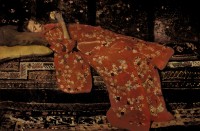 After the reopening of Japan to foreign trade in the 1850s and 1860s, European artists like Claude Monet, James McNeill Whistler and Vincent van Gogh were influenced by Japanese fine and decorative arts. One of Van Gogh’s friends and compatriots, George Hendrik Breitner, was inspired by the Japonisme trend to create a series of 13 paintings of a young girl wearing a kimono.
After the reopening of Japan to foreign trade in the 1850s and 1860s, European artists like Claude Monet, James McNeill Whistler and Vincent van Gogh were influenced by Japanese fine and decorative arts. One of Van Gogh’s friends and compatriots, George Hendrik Breitner, was inspired by the Japonisme trend to create a series of 13 paintings of a young girl wearing a kimono.
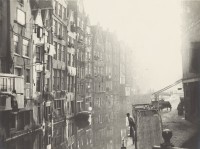 Breitner was born in Rotterdam in 1857. For the decade between 1876 and 1886 he studied and worked in The Hague where he explored working class areas of the city, sketching the people and places he encountered. He embraced the social realism movement and considered himself le peintre du peuple, the painter of the people. He moved to Amsterdam in 1886 where he was soon able to add photography to drawing and painting. Breitner took pictures of street life, people at work and going about their business in the city, some of the photographs reminiscent of the kind of work Jacob Riis was doing in the crowded and scary tenements of New York City at the same time.
Breitner was born in Rotterdam in 1857. For the decade between 1876 and 1886 he studied and worked in The Hague where he explored working class areas of the city, sketching the people and places he encountered. He embraced the social realism movement and considered himself le peintre du peuple, the painter of the people. He moved to Amsterdam in 1886 where he was soon able to add photography to drawing and painting. Breitner took pictures of street life, people at work and going about their business in the city, some of the photographs reminiscent of the kind of work Jacob Riis was doing in the crowded and scary tenements of New York City at the same time.
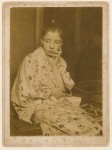 Breitner was one of the first artists to use photos as studies for specific paintings, not just of street scenes but in the studio as well. He integrated his social realist perspective in his studio portraits, making a point of employing models from the working class. One of them was a milliner’s shopgirl named Geesje Kwak who, along with her sister Anna, posed for Breitner in around 1893-1895 when she was 16-18 years old. It was Geesje Kwak who would be immortalized as the girl in a kimono.
Breitner was one of the first artists to use photos as studies for specific paintings, not just of street scenes but in the studio as well. He integrated his social realist perspective in his studio portraits, making a point of employing models from the working class. One of them was a milliner’s shopgirl named Geesje Kwak who, along with her sister Anna, posed for Breitner in around 1893-1895 when she was 16-18 years old. It was Geesje Kwak who would be immortalized as the girl in a kimono.
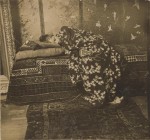 Japonisme had intrigued Breitner since he’d traveled to Paris in 1884. He collected Japanese woodcuts and in 1892 visited an exhibition of Japanese prints in The Hague. The show was his immediate inspiration for the kimono series. He acquired several Japanese kimonos and a pair of folding screens that he set up in his studio on the Lauriergracht canal. Geesje Kwak posed in the kimonos — one red, one white, one blue — against the backdrop of the folding screens on a bed draped in oriental rugs. She was paid for her time and there was no hanky panky going on; all strictly professional. Breitner kept meticulous records of which models posed for him when, for how long and at what rate.
Japonisme had intrigued Breitner since he’d traveled to Paris in 1884. He collected Japanese woodcuts and in 1892 visited an exhibition of Japanese prints in The Hague. The show was his immediate inspiration for the kimono series. He acquired several Japanese kimonos and a pair of folding screens that he set up in his studio on the Lauriergracht canal. Geesje Kwak posed in the kimonos — one red, one white, one blue — against the backdrop of the folding screens on a bed draped in oriental rugs. She was paid for her time and there was no hanky panky going on; all strictly professional. Breitner kept meticulous records of which models posed for him when, for how long and at what rate.
 Breitner’s work with Geesje Kwak ended when she emigrated to South Africa with her younger sister Niesje in 1895. Geesje died of tuberculosis in Pretoria in 1899, just shy of her 22nd birthday. The Girl in a Kimono series was not a success with critics initially, but today they are considered the pinnacle of the Dutch expression of Japonisme in the fine arts. The Rijksmuseum will celebrate the series with an unprecedented exhibition that brings together all of the Girl in a Kimono paintings, including a previously unpublished one from a private collection, plus the preliminary photographs, sketches and drawings Breitner used as studies for the paintings.
Breitner’s work with Geesje Kwak ended when she emigrated to South Africa with her younger sister Niesje in 1895. Geesje died of tuberculosis in Pretoria in 1899, just shy of her 22nd birthday. The Girl in a Kimono series was not a success with critics initially, but today they are considered the pinnacle of the Dutch expression of Japonisme in the fine arts. The Rijksmuseum will celebrate the series with an unprecedented exhibition that brings together all of the Girl in a Kimono paintings, including a previously unpublished one from a private collection, plus the preliminary photographs, sketches and drawings Breitner used as studies for the paintings.
There have been exhibitions in the past devoted to this beloved theme of Breitner’s, but the paintings of Girl in a Kimono have never been displayed all together. Displaying all the Girl in a Kimono works together, combined with the preliminary studies in the form of drawings, sketches and photographs, as well as Breitner’s easel and paint box, gives the exhibition above all an impression of the way in which the painter went about his work in his studio on the Lauriergracht in Amsterdam. […]
In total there are 20 paintings on display, including 13 Girl in Kimono works and one nude. Furthermore, 15 drawings and 15 photographs will be displayed, plus Japanese prints. Moreover, there are two beautiful kimonos from the same period as the ones worn in the paintings.
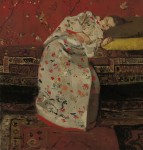
 Breitner: Girl in Kimono opens on February 20th and runs through May 22nd at the Rijksmuseum in Amsterdam.
Breitner: Girl in Kimono opens on February 20th and runs through May 22nd at the Rijksmuseum in Amsterdam.